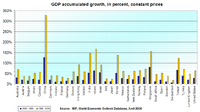
Photo from wikipedia
Introduction: Comparison of patients with extremely high and low values of a given characteristic is a common strategy to gain insights into disease mechanisms, but this approach is particularly susceptible… Click to show full abstract
Introduction: Comparison of patients with extremely high and low values of a given characteristic is a common strategy to gain insights into disease mechanisms, but this approach is particularly susceptible to regression to the mean (RTM). Objective: The aim of this work was to determine RTM in growth rate measurements in patients with geographic atrophy (GA) secondary to age-related macular degeneration. Methods: We conducted a retrospective analysis of the GAIN (NCT01694095) and its extension study, in which individuals 50 years or older with pure GA were followed for a minimum of 6 months. Two repeated and masked measurements of area of atrophy, both at baseline and final visits, were made, and growth rates were calculated for each. RTM was determined graphically and statistically, and the percentage of eyes misclassified as having fast and slow progression rates due to RTM was determined for different definitions of “fast” and “slow” growth. Results: We included 112 eyes of 112 patients: 64.3% were females, the mean age was 78.1 (SD ±7.6) years, and the mean follow-up time was 3.2 (±2.2) years. There was RTM, which decreased when the mean of two measurements was used. The magnitude of RTM in growth rates ranged from 2 to 11 µm/year and led to misclassification of eyes considered to have fast and slow growth between 2.9 and 10.3% of the cases, depending on the definition of fast and slow growth. Conclusions: RTM was present in measurements of GA growth rate, but it had a modest impact on patient misclassification. Comparison of features between patients with extreme growth rates is a reasonable strategy, but RTM should be minimized by taking the mean of two measurements.
Journal Title: Ophthalmic Research
Year Published: 2020
Link to full text (if available)
Share on Social Media: Sign Up to like & get
recommendations!